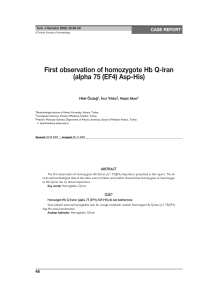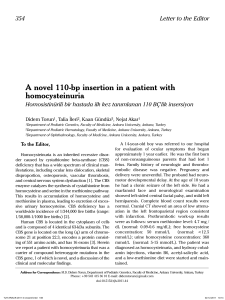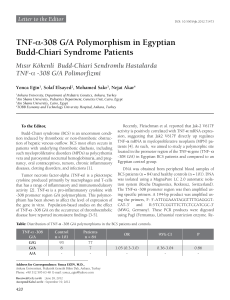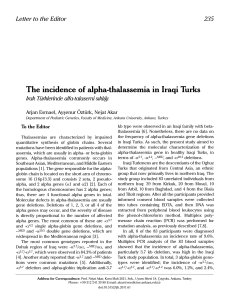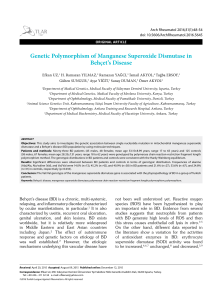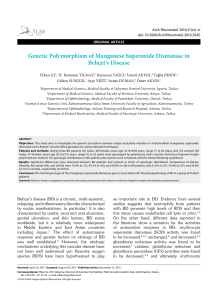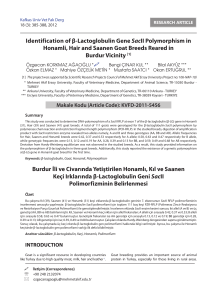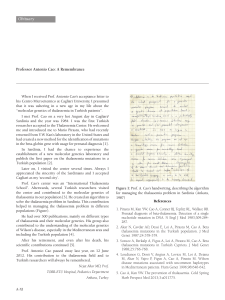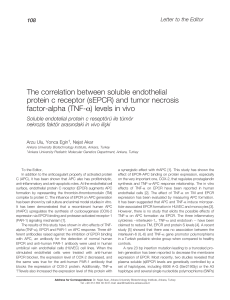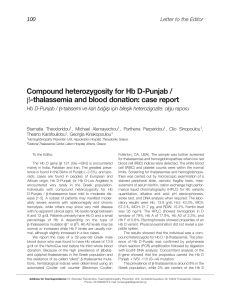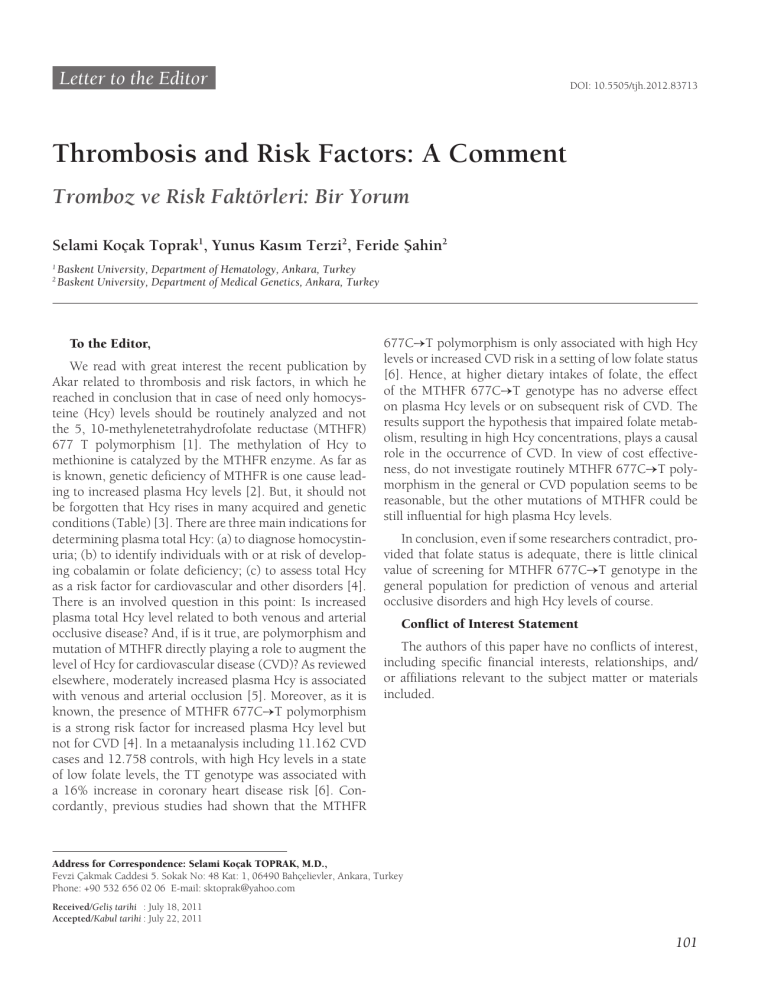
Letter to the Editor
DOI: 10.5505/tjh.2012.83713
Thrombosis and Risk Factors: A Comment
Tromboz ve Risk Faktörleri: Bir Yorum
Selami Koçak Toprak1, Yunus Kasım Terzi2, Feride Şahin2
1
2
Baskent University, Department of Hematology, Ankara, Turkey
Baskent University, Department of Medical Genetics, Ankara, Turkey
To the Editor,
We read with great interest the recent publication by
Akar related to thrombosis and risk factors, in which he
reached in conclusion that in case of need only homocysteine (Hcy) levels should be routinely analyzed and not
the 5, 10-methylenetetrahydrofolate reductase (MTHFR)
677 T polymorphism [1]. The methylation of Hcy to
methionine is catalyzed by the MTHFR enzyme. As far as
is known, genetic deficiency of MTHFR is one cause leading to increased plasma Hcy levels [2]. But, it should not
be forgotten that Hcy rises in many acquired and genetic
conditions (Table) [3]. There are three main indications for
determining plasma total Hcy: (a) to diagnose homocystinuria; (b) to identify individuals with or at risk of developing cobalamin or folate deficiency; (c) to assess total Hcy
as a risk factor for cardiovascular and other disorders [4].
There is an involved question in this point: Is increased
plasma total Hcy level related to both venous and arterial
occlusive disease? And, if is it true, are polymorphism and
mutation of MTHFR directly playing a role to augment the
level of Hcy for cardiovascular disease (CVD)? As reviewed
elsewhere, moderately increased plasma Hcy is associated
with venous and arterial occlusion [5]. Moreover, as it is
known, the presence of MTHFR 677C→T polymorphism
is a strong risk factor for increased plasma Hcy level but
not for CVD [4]. In a metaanalysis including 11.162 CVD
cases and 12.758 controls, with high Hcy levels in a state
of low folate levels, the TT genotype was associated with
a 16% increase in coronary heart disease risk [6]. Concordantly, previous studies had shown that the MTHFR
677C→T polymorphism is only associated with high Hcy
levels or increased CVD risk in a setting of low folate status
[6]. Hence, at higher dietary intakes of folate, the effect
of the MTHFR 677C→T genotype has no adverse effect
on plasma Hcy levels or on subsequent risk of CVD. The
results support the hypothesis that impaired folate metabolism, resulting in high Hcy concentrations, plays a causal
role in the occurrence of CVD. In view of cost effectiveness, do not investigate routinely MTHFR 677C→T polymorphism in the general or CVD population seems to be
reasonable, but the other mutations of MTHFR could be
still influential for high plasma Hcy levels.
In conclusion, even if some researchers contradict, provided that folate status is adequate, there is little clinical
value of screening for MTHFR 677C→T genotype in the
general population for prediction of venous and arterial
occlusive disorders and high Hcy levels of course.
Conflict of Interest Statement
The authors of this paper have no conflicts of interest,
including specific financial interests, relationships, and/
or affiliations relevant to the subject matter or materials
included.
Address for Correspondence: Selami Koçak Toprak, M.D.,
Fevzi Çakmak Caddesi 5. Sokak No: 48 Kat: 1, 06490 Bahçelievler, Ankara, Turkey
Phone: +90 532 656 02 06 E-mail: [email protected]
Received/Geliş tarihi : July 18, 2011
Accepted/Kabul tarihi: July 22, 2011
101
Toprak S K, et al: Thrombotic Risk Factors: A Comment
Turk J Hematol 2012; 29: 101-103
Table 1: Causes of Elevated Homocysteine Levels
CAUSES
Vitamin deficiency
Cobalamin deficiency
Folate deficiency
Disease
Renal failure
Posttransplantation
Hypothyroidism
Acute lymphocytic leukemia
Drugs and toxins
Alcohol abuse
Methotrexate and other antifols
Cyclosporine A
Nitrous oxide toxicity
Genetic disorders
Cystathionine β-synthase deficiency
Homozygous state
Heterozygous state
Hereditary disorders of cobalamin
Metabolism, transport, or absorption
Hereditary disorders of folate
Metabolism, transport, or absorption
Methylene tetrahydrofolate reductase
polymorphisms (homozygous C677T or
A1298C mutations)
Physiologic and lifestyle factors
Male sex
Aging
Coffee drinking
Smoking
EFFECT
Mild to severe
Mild to severe
Mild to moderate
Mild to moderate
Mild
Mild
Mild to severe
Mild to severe
Mild
Mild to severe
Severe
Mild or none
Mild to severe
Mild to severe
Mild or none
Mild
Mild
Mild
Mild
Modified from Carmel R. Megaloblastic Anemias: Disorders of Impaired DNA Synthesis. In: Greer JP, Foerster J, Rodgers GM, Paraskevas F,
Glader B, Arber DA, Means RT Jr, eds. Wintrobe’s Clinical Hematology. 12th ed. Philadelphia: Lippincott Williams & Wilkins, 2009: 1143-72.
References
1. Akar N. Thrombosis and risk factors. Turk J Hematol 2010;
27:318-9.
2. Yilmaz H, Isbir S, Agachan B, Ergen A, Farsak B, Isbir T.
C677T mutation of methylenetetrahydrofolate reductase
gene and serum homocysteine levels in Turkish patients
with coronary artery disease. Cell Biochem Funct. 2006;
24:87-90.
3. Carmel R. Megaloblastic Anemias: Disorders of Impaired
DNA Synthesis. In: Greer JP, Foerster J, Rodgers GM,
Paraskevas F, Glader B, Arber DA, Means RT Jr, eds.
Wintrobe’s Clinical Hematology. 12th ed. Philadelphia:
Lippincott Williams & Wilkins, 2009: 1143-72.
102
4.Refsum H, Smith AD, Ueland PM, Nexo E, Clarke R,
McPartlin J, Johnston C, Engbaek F, Schneede J, McPartlin
C, Scott JM. Facts and recommendations about total
homocysteine determinations: an expert opinion. Clin
Chem 2004; 50(1):3-32.
5.Refsum H, Ueland PM, Nygård O, Vollset SE. Homocysteine
and cardiovascular disease. Annu Rev Med. 1998; 49:31-62.
6. Klerk M, Verhoef P, Clarke R, Blom HJ, Kok FJ, Schouten
EG; MTHFR Studies Collaboration Group. MTHFR 677C->T polymorphism and risk of coronary heart disease: a
meta-analysis. JAMA. 2002;288(16):2023-31.
Turk J Hematol 2012; 29: 101-103
Reply
Thrombosis and Risk Factors
I read the comment of Toprak et al. on my letter to
the Editor appeared in a recent issue of the journal with
great interest [1]. They pointed a missing point in my letter and then focused on the effect of folate metabolism on
homocysteine and metihelenetetrahydrofolate gene polymorphism at 677 C to T extensively [1]
I would like to express my thanks to Toprak et al. giving a chance to explain my view on this matter once more.
As it is well known that there is a continuing debate
on homocysteine metabolism, MTHFR SNP’s and folate
metabolism and there are several published reviews on
this subject not reaching to a conclusion.
Recently we reported that MTHFR 677 T has an influence on Hcy levels in Turkish population. But also we
found another possible MTHFR gene haplotype, which
does not have an effect on Hcy levels [2].
Furthermore, there are also rare novel SNPs published
within the MTHFR 677 region with an allele frequency
of 1 in 3000-4000 sample, including MTHFR 678 C-A
(Ala222Ala) in Turkish population [3-5] which may lead
to erroneous technical reporting.
Toprak S K, et al: Thrombotic Risk Factors: A Comment
References
1. Akar N: Thrombosis and risk factors. Turk J Hematol 2010:
27 (4) : 318-319
2. Koç YL, Akar N: Single nucleotide polymorphisms that
affect homocysteine levels in Turkish population. Clin Appl
Thromb Hemost 2009; 15: 701-704
3.Lyon E: Discovering rare variants by use of melting
temperature shifts seen in melting curve analysis. Clin
Chem 2005; 51: 1331-1332
4. Erali M, Schmidt B, Lyon E, Wittwer C: Evaluation of
electronic microarrays for genotyping factor V, factor II, and
MTHFR. Clin Chem 2003; 49: 732-739
5. Eğin Y, Akar N: First observation of MTHFR 678 C-A
(Ala222Ala) single nucleotide polymorphism. Turk J
Hematol 2011 (DOI: 10.5152/tjh.2011.45)
6. Akar N, Akar E, Misirlioğlu M, Avcu F, Yalçin A, Cin S:
Search for genetic factors favoring thrombosis in Turkish
population. Thromb Res 1998; 92 (2): 79-82
Nejat Akar
TOBB Economy and Technology University Hospital, Ankara, Turkey
Since our first publication on homocysteine related
gene polymorphisms in Turkish population in 1998 [6],
and the others following the first paper, I reached to a
conclusion that without determining homocysteine levels, analyzing MTHFR 677C-T solely at the DNA level
is unnecessary, not cost effective and does not have any
clinical value especially in Turkish population.
So, only homocysteine levels should be routinely analyzed and not the MTHFR 677 T SNP alone. If any cause
of high homocysteine levels could not be found, then
MTHFR 677 T analysis can be performed.
103



